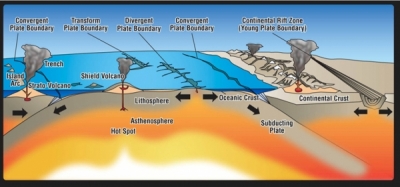
|
The surface of Earth is broken into giant fragments called tectonic plates. The continents are situated on top of these tectonic plates, which carry them much like cargo on rafts. The plates move at rates of between 2 and 17 cm per year, and over millions of years this moves the continents over many thousands of kilometres. |
The earth’s crust is broken into separate pieces called tectonic plates. The crust is the solid, rocky, outer shell of the planet. It is composed of two distinctly different types of material: the less-dense continental crust and the more-dense oceanic crust. Both types of crust rest atop solid, upper mantle material. The upper mantle, in turn, floats on a denser layer of lower mantle that is much like thick molten tar.
Each tectonic plate is free-floating and can move independently. Earthquakes and volcanoes are the direct result of the movement of tectonic plates at fault lines. The term fault is used to describe the boundary between tectonic plates. Most of the earthquakes and volcanoes around the Pacific ocean basin—a pattern known as the “ring of fire”—are due to the movement of tectonic plates in this region. Other observable results of short-term plate movement include the gradual widening of the Great Rift lakes in eastern Africa and the rising of the Himalayan Mountain range. The motion of plates can be described in four general patterns:
- Collision: when two continental plates are shoved together
- Subduction: when one plate plunges beneath another
- Spreading: when two plates are pushed apart
- Transform faulting: when two plates slide past each other
Credit: EXPLORING OUR FLUID EARTH
Picture Credit : Google




